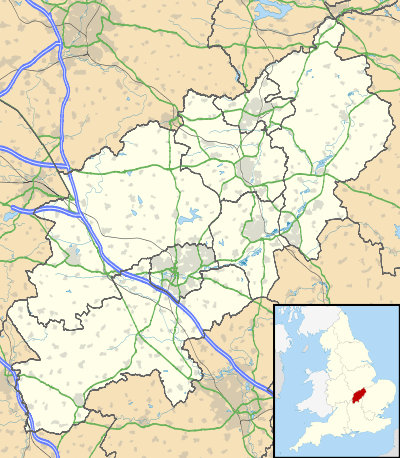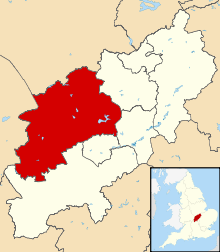Scaldwell
Scaldwell is a village and civil parish in the Daventry district, Northamptonshire, England.
| Scaldwell | |
|---|---|
 Scaldwell Location within Northamptonshire | |
| Population | 302 (2011) |
| OS grid reference | SP7672 |
| District |
|
| Shire county | |
| Region | |
| Country | England |
| Sovereign state | United Kingdom |
| Post town | Northampton |
| Postcode district | NN6 |
| Dialling code | 01604 |
| Police | Northamptonshire |
| Fire | Northamptonshire |
| Ambulance | East Midlands |
| UK Parliament | |
Scaldwell is tiny and has neither shops nor pubs; at the time of the 2001 census the parish had a population of 271 living in 113 households,[1] increasing to 302 at the 2011 Census.[2] It has an ageing population. The nearest place for school, shop or pub is Brixworth. Scaldwell has a church dedicated to Saints Peter and Paul. It has a Norman tower and some 13th century-features and was restored in 1863.[3] The village has a traditional green and was mentioned in the Domesday Book.
Ironstone quarrying and the Scaldwell Tramway
Iron ore was quarried around Scaldwell by the Staveley Coal and Iron Company from 1912 until 1963. The company operated a number of ironstone quarries around the villages of Brixworth, Hanging Houghton and Scaldwell. The first pits lay to the east of the Scaldwell to Brixworth Road close to Scaldwell, and began producing ore in April 1913.[4]
Two separate 3 ft (914 mm) gauge tramways transported ore from the quarries, one serving the Hanging Houghton pits, the second longer tramway, starting at Scaldwell and serving all the other quarries. An aerial ropeway was installed to connect the two tramway systems to sidings on the Market Harborough to Northampton railway line. The pits were originally hand worked, but in 1933 steam dragline excavators were introduced, which made the quarrying faster and more efficient.
In 1914, new pits were opened near Grange Farm, a mile south of Scaldwell. The Scaldwell tramway was extended to these pits. New ore fields were leased just south of Brixworth village in 1939 and again the tramway was extended to reach them. These Brixworth pits continued in production until 1949 when the pits were abandoned and the tramway extension removed.
During the Second World War, a new standard gauge branch line was laid to connect the sidings to the Hanging Houghton quarries; from then on the output from those quarries was no longer carried by the aerial ropeway. This branch was extended to Scaldwell in 1954, and the aerial ropeway was abandoned. From then on, ore was tipped from narrow to standard gauge wagons at Scaldwell. The final ironstone pits in use were a mile and a half south-east of Scaldwell at New Grange Farm. These ceased working in December 1962 and the entire system was abandoned. The narrow gauge tramway and standard gauge branch were removed by 1964, and the remaining pits were landscaped and returned to agricultural use.
The final iron ore quarrying in Scaldwell was in the northern pit which operated close to Lamport village between 1961 and 1963 This was served by the standard gauge tramway. By then diesel and electric quarrying machines were used. The tramways used steam locomotives throughout the time they operated.[5]
Notable people
- Edward Hume (1841–1921), cricketer
References
- Office for National Statistics: Scaldwell CP: Parish headcounts. Retrieved 19 November 2009
- "Civil Parish population 2011". Neighbourhood Statistice. Office for National Statistics. Retrieved 9 July 2016.
- Pevsner, Nilkolaus (1972). Cherry, Bridget (ed.). Northamptonshire. Buildings of England (Second ed.). London: Penguin. p. 402. ISBN 0-14-0710-22-1.
- Quine, Dan (2016). Four East Midlands Ironstone Tramways Part Four: Scaldwell. 112. Garndolbenmaen: Narrow Gauge and Industrial Railway Modelling Review.
- Tonks, Eric (April 1989). The Ironstone Quarries of the Midlands Part 3: The Northampton Area. Cheltenham: Runpast Publishing. p. 185-221. ISBN 1-870-754-034.
External links
| Wikimedia Commons has media related to Scaldwell. |
- Some details of the church's architecture
- Map sources for Scaldwell
